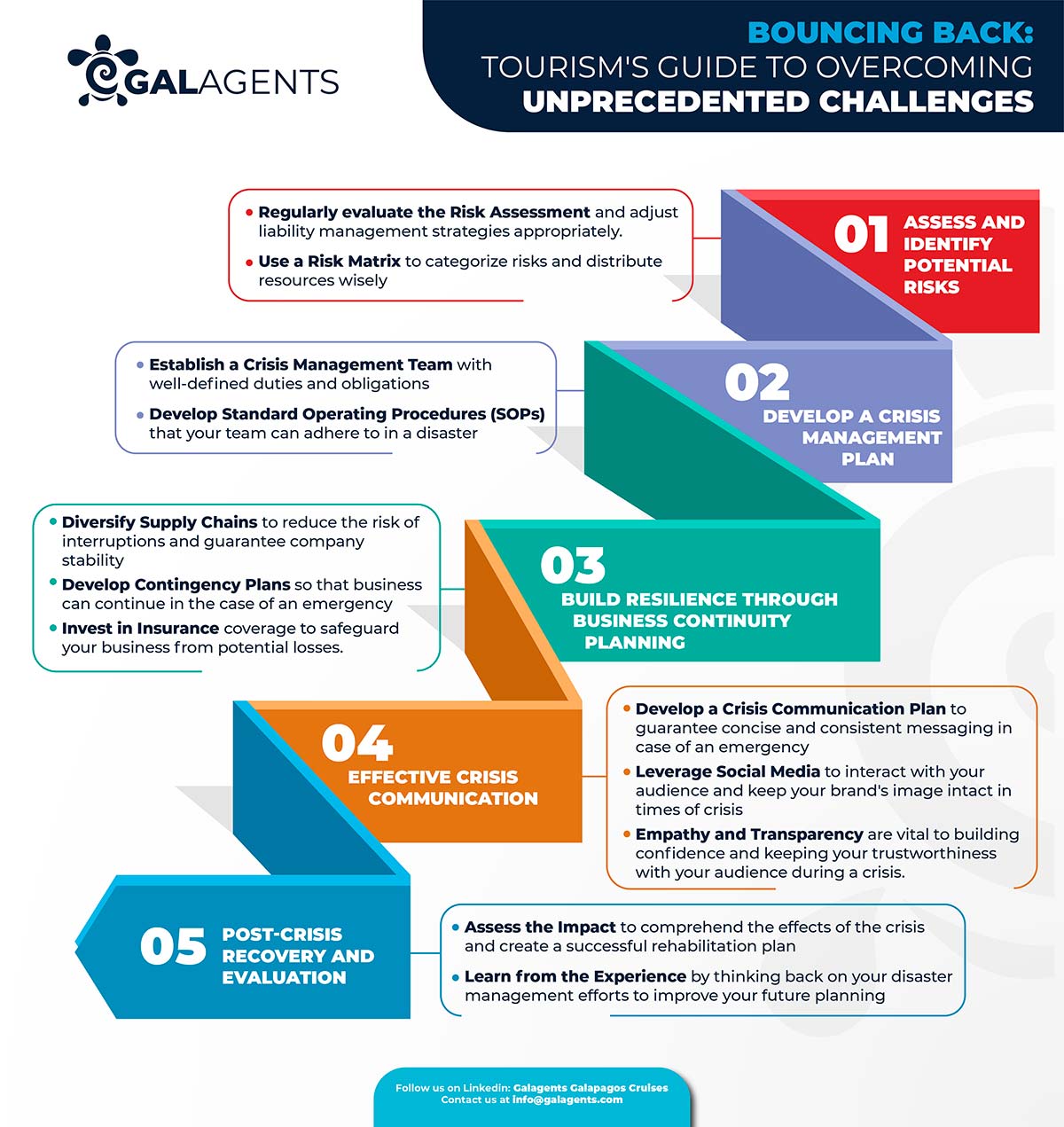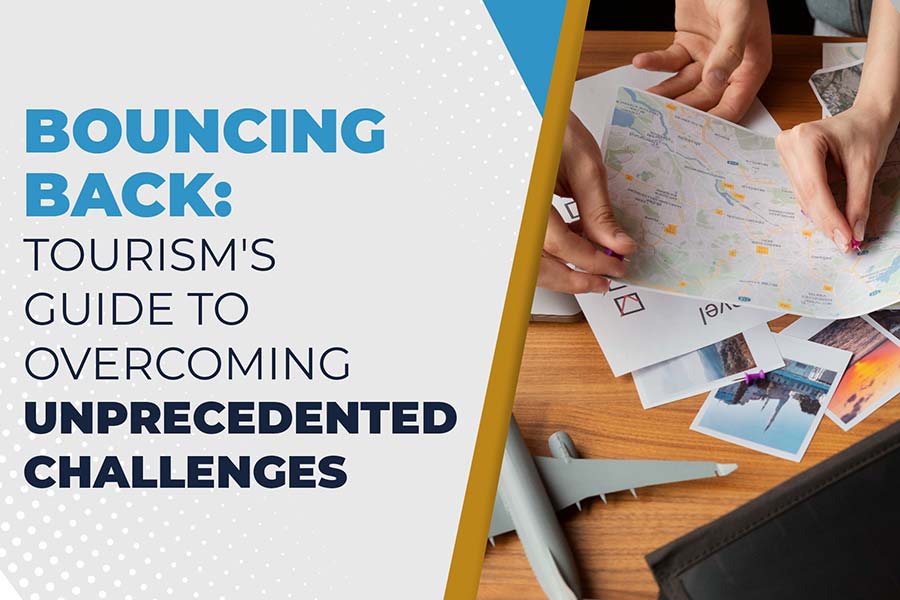It’s 2020, and travel is more popular than ever. A rising tide of interested travelers is lifting the industry. But, then, COVID-19 hits, stopping global activity and leaving travel companies facing massive challenges.
This story shows the struggles that tourism, and all of us, have had to overcome in recent years. The sector’s susceptibility to crises such as the pandemic, environmental catastrophes, political instability, and economic downturns highlighted the need for effective crisis management strategies.
In this article, we will discuss the significance of crisis management in the tourist industry and provide helpful guidelines for maintaining operational stability in the face of hardship. By implementing these standards, your company will be better prepared to weather any storm and emerge stronger on the other side.

download the guide here
1. Assessing and Identifying Potential Risks
We can learn the value of anticipating and mitigating threats in the tourist business by looking back at similar situations. Let’s take a look at two crucial aspects of risk evaluation:
Risk Assessment / The Indian Ocean Tsunami of 2004:
This catastrophic event caused enormous devastation and loss of life in the coastal areas. It emphasized the significance of developing comprehensive risk assessments for tourist companies, in which possible threats and their consequences are identified.
Key insight: Regularly assess the state of threats and adjust risk management strategies appropriately.
2. Developing a Crisis Management Plan
During emergencies, a well-organized crisis management strategy can be of great help. Here are two crucial factors to think about:
Establishing a Crisis Management Team / The Hurricane Katrina of 2005:
Hurricane Katrina’s destruction of New Orleans made clear the need for a committed crisis management team that can facilitate decision-making and guarantee an efficient reaction.
Key insight: Create a crisis management team with well-defined duties and obligations.
Developing Standard Operating Procedures (SOPs) / The H1N1 Influenza Outbreak of 2009:
The outbreak among tourists and companies brought on confusion and fear. Tourism providers can react calmly and effectively with clear SOPs, minimizing the effects on their companies.
Key insight: Create comprehensive SOPs that your team can adhere to in a disaster.
3. Building Resilience through Business Continuity Planning
The 2008 global financial crisis crippled many tourism businesses. To withstand such economic shocks, it’s crucial to build resilience through business continuity planning:
Diversifying Supply Chains / The COVID-19 Pandemic:
The epidemic made the weakness of international supply networks clear. As a result, the danger of disruptions can be decreased, and business can continue during a crisis by diversifying vendors and geographical areas.
Key insight: To reduce the risk of interruptions and guarantee company stability, diversify your supply chain.
Developing Contingency Plans / The Fukushima Nuclear Disaster of 2011:
This catastrophe caused travel cancellations and general dread. Therefore, plans for emergencies, such as backup lodging and transit choices, can lessen the effect on the tourist industry.
Key Insight: Create backup plans so that business can continue in the case of an emergency.
Investing in Insurance / The Hurrican Season of 2017:
The devasting hurricane season in the Caribbean served as a stark reminder of the value of complete insurance protection for companies against monetary losses during emergencies.
Key insight: Invest in appropriate insurance coverage to safeguard your business from potential losses.
4. Effective Crisis Communication
These three crucial elements serve as illustrations of why prompt and clear communication is essential during a crisis:
Developing a Crisis Communication Plan / The Boston Marathon Bombing of 2013:
There was a lot of uncertainty and misinformation following the explosion. During crises, a crisis communication strategy can assist tourism companies in giving stakeholders correct information and direction.
Key insight: Make a strategy for disaster communication that will guarantee concise and consistent messaging.
Leveraging Social Media / The Nepal Earthquake of 2015:
During the tremor, social media was instrumental in getting the word out. Utilizing social media platforms, tourism companies can monitor public opinion, react to concerns raised, and maintain their image.
Key insight: Use social media to interact with your audience and keep your brand’s image intact in times of crisis.
Empathy and Transparency / The COVID-19 Pandemic:
The epidemic brought home the importance of communicating with sensitivity and openness. Maintaining confidence and believability can be facilitated by acknowledging the situation, showing worry for those impacted, and offering frequent updates.
Key insight: Use empathy and openness in your crisis communications to build confidence and keep your trustworthiness with your audience.
5. Post-Crisis Recovery and Evaluation
For future readiness, it is crucial to learn from previous crises:
Assessing the Impact / Las Vegas Shooting of 2017:
Tourism suffered significantly from this tragic incident, with many companies facing financial setbacks and social harm. However, businesses can create a recovery plan that tackles problems and aids in their comeback by evaluating the effect of a disaster.
Key insight: To comprehend the effects of the crisis and create a successful rehabilitation plan, carry out a comprehensive post-crisis assessment.
Learning from the Experience / The BP Oil Spill of 2010:
The Gulf of Mexico oil disaster seriously harmed the ecology and local tourism. However, it is possible to find areas for development and integrate these insights into plans and processes by analyzing the efficacy of crisis management and reaction efforts.
Key insight: Think back on your disaster management efforts and apply the lessons you learned to your future planning.
Imagine it’s 2024, and the travel and tourism sector has risen from the ashes of previous disasters stronger than ever. Because you incorporated historical lessons and valuable insights into your crisis management plan, your company has prospered. You experience a feeling of accomplishment as you greet visitors worldwide after surviving the unpredictable tourist industry.
We encourage you to embrace the knowledge and insights acquired from previous disasters as you proceed, using them as a guide to bolster your company against impending difficulties. You can be ready to confront the unforeseen with confidence by taking preemptive measures, such as evaluating risks, creating a crisis management plan, developing strength, improving communication, and learning from previous experiences.
Although the tourist sector’s future is still being determined, you can forge a better, more resilient future using the knowledge of the past. So let’s band together to study the past, take action, and create a prosperous future for our companies and the world’s tourist industry.

